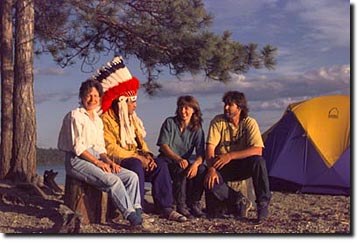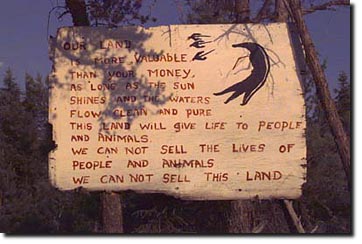Obabika Inlet to Lake Obabika
As we paddled out of Obabika Inlet, I noticed what looked like a floating log crossing the channel some distance ahead. Too big for a beaver... my view through the binoculars revealed a black bear. By the time we caught up with it, this sleek, healthy-looking black bear had emerged from the water. Following a shake, it made its way up the scree slope. Rocks tumbling, bark scraping. The bear was in no hurry, turning often to look back at us.
At the next portage, a whole group of canoeists were busy coming the other way. Since the opening to the lake was small, their six canoes took up all the space. We had fun photographing the yelllow and white lilies that have all in flower while we waited. Then a familiar voice came through the forest to us... Allie Myers, it has to be. Allie is the other member of our dogsledding journey next winter and, although we knew she was guiding for Camp Wanapitai ( a longtime canoe camp in the area, I didn't really think we would run across her. We were in behind a hedge of pink sheep laurel. I pushed off sliding the canoe's stern past the portage opening just as Allie appeared. Gary held up his telephoto lens.."Smile Allie!" What a great surprise and Kalija noticed her right away. In all the excitment we forgot to bring out the digital camera .... We hurriedly exchanged experiences since we'd last since one another in early June, then they headed one way and we the other. "See you in September!" we called. Allie will by then be working with Craig full time training the sled dogs.
The portage into Obabika proved easy...a wide open trail. Lake Obabika itself was mirror calm with puffy cumulous clouds reflected in its surface. We were way out in the middle... Gary taking photographs and me paddling. I reached into a small pack behind me and heard something fall overboard. "Oh no, my shoe!" But no, it was something even far more valuable. I jumped overboard sunglasses on and all. I could see the fishing rod spirling down down down... way below me. The waters are so clear but unfortunately for me, really deep right here. I burst back to the surface feeling terrible. It was Gary's 30-year old fishing reel, a Mitchell 301 for left-handed people and they don't make them anymore. He'd had it since he was a little boy. Gary remarked "My ultimate sacrifice to Lake Obabika. Don't worry, it's gone now." and then we carried on, moving closer to shore and following a blue heron as it kept its distance flying ahead of us and landing, flying ahead and landing.
We camped early on a beautiful sand point near a special place, a cliff and a big piece of rock standing out from shore. A place where tobacco offerings are left for the old man and the old woman. Another group came paddling down the lake and camped on the island out front... this group turned out to be folks who had come out for the evening at Lady Evelyn Outfitting in the town of Temagami. Given all the islands, bays, lakes and rivers, the possible routes through and around seem limitless yet we still meet up with people we know. Everytime I had seen a group of young people from the local camps setting up their tents, or paddling by us, or on the portage trail... I think how grand it is that they are here. What incredible lifetime experiences the land is able to teach them. And I had been thinking earlier in the day that these camps have the perfect opportunity of providing their trip leaders with a greater understanding of the forest they are paddling through and the incredible wealth of aboriginal history and stories best told by the Anishnabe elders in the region. Talking and listening to some of the campers and their leaders, I wasn't sure how much of this was being done.
A little later on, a young group of campers from NorthWaters (which Gary had met on the Obabika portage) ended up camping nearby and one of their leaders came over kindly requesting the site since it was so close to us. "Alex Mathias, one of the local Anishnabe elders met us on the portage trail. He's coming over later to tell us some stories." I made tea and scones when Alex arrived with his wife, MaryCarol. Before going over to the campers, they shared some of the history of the place where we were camped. Alex showed us the foundations for the old ranger station and where the firetower used to be. They pulled out a sheaf of black and white photographs which included pictures of Alex as a boy growing up in the area... some even taken right here on this lake, at this spot. We had so much we wanted to hear and learn ... and look at maps together so we decided we'd paddle over the following day and spend it with them. The night ended with stories Alex told to the girls from NorthWater Camp. An experience etched in their memories forever as Alex was dressed in a fine deerskin coat and his feathered headdress.
Lake Obabika
Paddled over to have coffee with the folks camped on the island then on to Alex and MaryCarol's cabin at the mouth of the Obabika River. When we arrived, a few of Alex's sled dogs came down to shore to greet us. Alex was preparing special pancakes (made with frozen blueberries picked last summer) over an open fire, and the grill, an old wire spring bed, was an unusual sight.. A-1 pancakes said Leo Paul, family head of the White Bear. He was staying with Alex and Mary Carol, along with friends from southern Ontario. Bill and Ann Buchan come as often as they can to help keep the Obabika trails cleared. This time they brought along two young lads from Bill's music class, Colin Sloss and Leon Taheny. A great experience for them. As the morning unfolded, it was decided that we would venture up to the Obabika Trails for a hike. MaryCarol's 9 year old daughter, Carollee, came with us too.

Alex and Mary Carol
A south wind blew us up the lake. Landing on a small sand beach we headed into the quiet forest....quiet on a summer afternoon with just the song of the whitethroat and phobe. All the pale green of spring is gone except the new growth on the spruce. The berries of bunchberry, bluebead, lily of the valley are appearing green and hard. Soon they'll ripen with the blueberries. The smell of sweet fern prevailed on the higher parts of the trail where red pine grew in the sandy stony soil. Down lower, we passed beneath some of the red and white pine giants that have made the Obabika old growth famous. Huge piles of husked cones lie at the base of many trees, places where the red squirrels have been feeding. Cones of red pine, jack pine, white pine and black spruce are scattered about on the forest floor. Everywhere new feathery white pine seedlings are emerging... through the ferns, along decaying logs, amongst some birch. Everywhere there is a feeling of wholeness. The soil beneath us, soft and rich with decaying wood and threaded with many runner plants like snowberry and twinflowers. There are the mosses, fungi and lichens. There are shrubs and trees of all ages. Snags, dead standing trees full of pileated woodpecker holes, provide nesting cavities and denning areas. The fallen logs of big pine are not wasted, the thread of their lives picked up in the many seedlings emerging from the prone forms on the forest floor. Nothing is wasted. Time here is a long time in our human terms. Several hundred years for processes to take place...there is no hurrying this and there is no replacing this. The complex inter-relationships of species; plant, animal, insect... and the processes of growth and decay, fire and wind all play their role. The big, old red and white pine within the forest are an endangered species on the North American landscape. And the original, ancient Great Lakes-St. Lawrence type forest of which they are a part, is an endangered ecosystem. As we walked along the 6 miles of trails, we were struck by the knowledge of how small the area really was in comparison to all of Temagami... all of Ontario... all of North America. Yet it represents one of the finest examples of the less than 1% which remains on the North American landscape.

We passed this sign on the portage between Chee-sko-way and Diamond Lakes. Being on a long canoe trip helps us appreciate the simple, clear message in these words. The lands and waters, when cared for, have the ability to continue sustaining all the life that has evolved there for thousands of years, and for many generations to come.
Half way through the hike, we emerged on the shores of Shish--kong-abikong, which means the place of the huge rock. On the opposite shore, a stone pillar stands out along the steep cliffs where scree falls to the lake. It is a majestic and sacred site, and one that we sit and admire for a while before returning.
The day ends with a visit to MaryCarol's garden overlooking the Obabika river. A peaceful place to pull up roots and water the emerging potatoes, squash, carrots and herbs. Alex points out the foundations of a cabin. His mother had a garden here long ago and many things were thrown out into it. A collection of rusty traps and tools found while digging the garden that spring, lie in a neat row between the forest and garden. A family of mergansers pass. This is the river Alex fishes for ling. Each season brings something new as living on the land requires ingenuity and knowledge.
Goodnight from the Ancient Forest Water Trail.